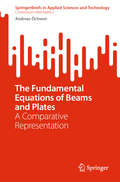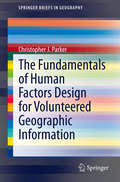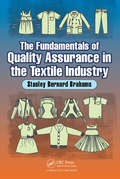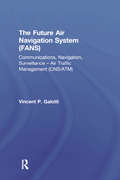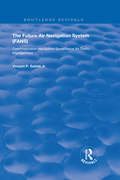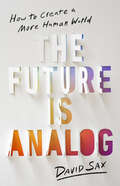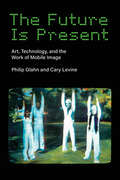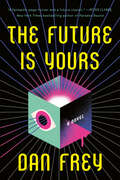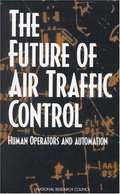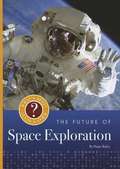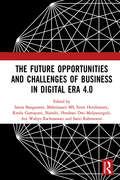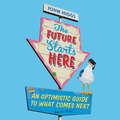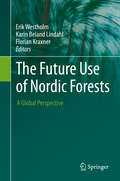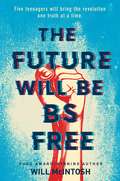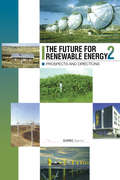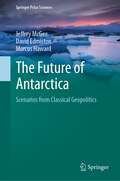- Table View
- List View
The Functional Foods Revolution: "Healthy People, Healthy Profits"
by Michael Heasman Julian MellentinFoods that promote human health - 'functional foods' or nutraceuticals - have caught the imagination of the global food industry. All the household-name companies are developing them as a key driver in their global strategies. They see the prospect of new markets and bigger margins, but the issues presented are fraught with complexity and difficulties. Distinguishing hype from real hope, the authors of this handbook explain the dilemmas and contradictions the industry faces. They present a wealth of detailed marketing, food policy and regulatory material from the leading markets world-wide and show how the hopes of the industry, and the consumer, may be dashed. The solution they offer is radical - nothing less than a new business model of what they term a healthful company.
The Fundamental Equations of Beams and Plates: A Comparative Representation (SpringerBriefs in Applied Sciences and Technology)
by Andreas ÖchsnerThis book focuses on beam and plate elements, essential components found across various fields from automotive and aerospace engineering to civil engineering structures. It offers a comparative exploration of the fundamental equations governing thin and thick beams, as well as thin and thick plates, providing readers with a clear understanding of these foundational structural elements. By explaining the three fundamental equations of continuum mechanics—equilibrium, kinematics, and constitution—the text culminates in a unified differential equation framework, offering both beginners and experienced practitioners a fresh perspective on structural member modeling.
The Fundamentals of Human Factors Design for Volunteered Geographic Information
by Christopher J. ParkerThis book explores the roles in which volunteered and professional information play within neogeography from a human factors perspective. The unique advantages of each information type are considered alongside how they may be utilised to create products and services delivering highly functional, efficient and satisfying experiences to their users. The overall aim of this book is to address the issue of how Volunteered Geographic Information (VGI) can be combined with Professional Geographic Information (PGI) to satisfy the information search requirements of consumer-users via highly usable mashups. Firstly, this required the development of an understanding of the way different users perceive VGI and PGI in terms of its benefits to their activities and information needs. Secondly, the benefits that VGI may bring to the user experience of a mashup (which cannot be attained through the use of PGI) needed to be understood. In order to achieve this, a user centred design perspective was implemented throughout the research.
The Fundamentals of Process Intensification
by Andrzej Stankiewicz Tom Van Gerven Georgios StefanidisThis advanced textbook covering the fundamentals and industry applications of process intensification (PI) discusses both the theoretical and conceptual basis of the discipline. Since interdisciplinarity is a key feature of PI, the material contained in the book reaches far beyond the classical area of chemical engineering. Developments in other relevant disciplines, such as chemistry, catalysis, energy technology, applied physics, electronics and materials science, are extensively described and discussed, while maintaining a chemical engineering perspective. Divided into three major parts, the first introduces the PI principles in detail and illustrates them using practical examples. The second part is entirely devoted to fundamental approaches of PI in four domains: spatial, thermodynamic, functional and temporal. The third and final part explores the methodology for applying fundamental PI approaches in practice. As well as detailing technologies, the book focuses on safety, energy and environmental issues, giving guidance on how to incorporate PI in plant design and operation -- safely, efficiently and effectively.
The Fundamentals of Quality Assurance in the Textile Industry
by Stanley Bernard BrahamsThe role of quality assurance is to ensure that once a specification has been agreed, every product and every production run meets that standard. The Fundamentals of Quality Assurance in the Textile Industry describes how quality professionals in the apparel industry coordinating with overseas factories can ensure excellence. The author explains what tools are required and how to manage products from style conception to finished production and the methods used to track and evaluate samples and production at each stage of the critical path. This book reinforces the concept that quality assurance must become an integral part of the business and details crucial procedures that have been adopted internationally.
The Fusion of Internet of Things, Artificial Intelligence, and Cloud Computing in Health Care (Internet of Things)
by Ajith Abraham Patrick Siarry Ana Madureira M. A. Jabbar Rajanikanth AluvaluThis book reviews the convergence technologies like cloud computing, artificial intelligence (AI) and Internet of Things (IoT) in healthcare and how they can help all stakeholders in the healthcare sector. The book is a proficient guide on the relationship between AI, IoT and healthcare and gives examples into how IoT is changing all aspects of the healthcare industry. Topics include remote patient monitoring, the telemedicine ecosystem, pattern imaging analytics using AI, disease identification and diagnosis using AI, robotic surgery, prediction of epidemic outbreaks, and more. The contributors include applications and case studies across all areas of computational intelligence in healthcare data. The authors also include workflow in IoT-enabled healthcare technologies and explore privacy and security issues in healthcare-based IoT.
The Future Air Navigation System: Communications, Navigation, Surveillance – Air Traffic Management (CNS/ATM) (Routledge Revivals Ser.)
by Vincent P. GalottiIn view of the increase in air traffic, there has been a great deal of work by the nations of the world, under the auspices of ICAO, toward developing the concept for a future air navigation infrastructure to serve worldwide civil aviation efficiency. Even though the concept is well described and implementation is beginning, only technical manuals are available to advance the systems concept. This book describes the global vision for the Future Air Navigation System (FANS) and is the first text of its kind dedicated solely to Communications Navigation, Surveillance/Air Traffic Management and the CNS/ATM systems concept. In addition to the technical issues associated with CNS/ATM, the book also examines institutional, economic, labour and Human Factors issues. It is designed as a text usable in the classroom environment in universities and aviation technical schools.
The Future Air Navigation System: Communications, Navigation, Surveillance – Air Traffic Management (CNS/ATM) (Routledge Revivals)
by Vincent P. GalottiFirst published in 1997, this volume responds to the increase in air traffic, as there has been a great deal of work by the nations of the world, under the auspices of ICAO, toward developing the concept for a future air navigation infrastructure to serve worldwide civil aviation efficiency. Even though the concept is well described and implementation is beginning, only technical manuals are available to advance the systems concept. This book describes the global vision for the Future Air Navigation System (FANS) and is the first text of its kind dedicated solely to Communications Navigation, Surveillance/Air Traffic Management and the CNS/ATM systems concept. In addition to the technical issues associated with CNS/ATM, the book also examines institutional, economic, labour and Human Factors issues. It is designed as a text usable in the classroom environment in universities and aviation technical schools.
The Future European Energy System: Renewable Energy, Flexibility Options and Technological Progress
by Dominik Möst Steffi Schreiber Andrea Herbst Martin Jakob Angelo Martino Witold-Roger PoganietzThis open access book analyzes the transition toward a low-carbon energy system in Europe under the aspects of flexibility and technological progress. By covering the main energy sectors – including the industry, residential, tertiary and transport sector as well as the heating and electricity sector – the analysis assesses flexibility requirements in a cross-sectoral energy system with high shares of renewable energies. The contributing authors – all European energy experts – apply models and tools from various research fields, including techno-economic learning, fundamental energy system modeling, and environmental and social life cycle as well as health impact assessment, to develop an innovative and comprehensive energy models system (EMS). Moreover, the contributions examine renewable penetrations and their contributions to climate change mitigation, and the impacts of available technologies on the energy system. Given its scope, the book appeals to researchers studying energy systems and markets, professionals and policymakers of the energy industry and readers interested in the transformation to a low-carbon energy system in Europe.
The Future Is Analog: How to Create a More Human World
by David SaxBestselling culture writer David Sax lays out the case against a false digital utopia—and for a more human future In The Future Is Analog, David Sax points out that the onset of the pandemic instantly gave us the digital universe we&’d spent so long anticipating. Instant communication, online shopping, virtual everything. It didn&’t take long to realize how awful it was to live in this promised future. We craved real experiences, relationships, and spaces and got back to real life as quickly and often as we could. In chapters exploring work, school, religion, and more, this book asks pointed questions: Is our future inevitably digital? Can we reject the downsides of digital technology without rejecting change? Can we innovate not for the sake of productivity but for the good of our social and cultural lives? Can we build a future that serves us as humans, first and foremost? This is a manifesto for a different kind of change. We can spend our creativity and money on building new gadgets—or we can spend them on new ways to be together and experience the world, to bake bread, and climb mountains. All we need is the clarity to choose which future we want.
The Future Is Present: Art, Technology, and the Work of Mobile Image (Leonardo)
by Cary Levine Philip GlahnA critical history of the pioneering art and technology group Mobile Image and their prescient work in communications, networking, and information systems.In The Future Is Present, Philip Glahn and Cary Levine tell the fascinating history of the visionary art group Mobile Image—founded by Kit Galloway and Sherrie Rabinowitz in 1977—which appropriated emerging technologies, from satellites to electronic message platforms. Based in Los Angeles, this under-studied collective worked amid urban crisis, a techno-boom, consolidating media power, and ascendant neoliberal politics. Mobile Image challenged fundamental conventions of the public sphere, democracy, communication, and political participation, as well as notions of power, representation, and identity.Glahn and Levine argue not only for the historical importance of Mobile Image, but also for a critical artistic process that is at once analytic and transformative. They weave themes such as embodiment and its mediation, public/private dialectics, and techno-utopian vision throughout the book, binding these projects to discourses around race, gender, and class, as well as margin and center, the local and the global. In today&’s world of ubiquitous digital re/production, networking, and social media, The Future Is Present shows how the work of Mobile Image continues to have profound implications for art, technology, and the politics of public and private experience.
The Future Is Yours: A Novel
by Dan FreyTwo best friends create a computer that can predict the future. But what they can&’t predict is how it will tear their friendship—and society—apart.&“An impossibly addictive brainteaser wrapped in a buttery popcorn kernel.&”—Aneesh Chaganty, director and co-writer of Searching and RunIN DEVELOPMENT AS AN HBO MAX ORIGINAL SERIESIf you had the chance to look one year into the future, would you? For Ben Boyce and Adhi Chaudry, the answer is unequivocally yes. And they&’re betting everything that you&’ll say yes, too. Welcome to The Future: a computer that connects to the internet one year from now, so you can see who you&’ll be dating, where you&’ll be working, even whether or not you&’ll be alive in the year to come. By forming a startup to deliver this revolutionary technology to the world, Ben and Adhi have made their wildest, most impossible dream a reality. Once Silicon Valley outsiders, they&’re now its hottest commodity. The device can predict everything perfectly—from stock market spikes and sports scores to political scandals and corporate takeovers—allowing them to chase down success and fame while staying one step ahead of the competition. But the future their device foretells is not the bright one they imagined.Ambition. Greed. Jealousy. And, perhaps, an apocalypse. The question is . . . can they stop it?Told through emails, texts, transcripts, and blog posts, this bleeding-edge tech thriller chronicles the costs of innovation and asks how far you&’d go to protect the ones you love—even from themselves.
The Future Of Air Traffic Control: Human Operators And Automation
by Panel on Human Factors in Air Traffic Control AutomationAutomation in air traffic control may increase efficiency, but it also raises questions about adequate human control over automated systems. Following on the panel's first volume on air traffic control automation, Flight to the Future (NRC, 1997), this book focuses on the interaction of pilots and air traffic controllers, with a growing network of automated functions in the airspace system.The panel offers recommendations for development of human-centered automation, addressing key areas such as providing levels of automation that are appropriate to levels of risk, examining procedures for recovery from emergencies, free flight versus ground-based authority, and more.The book explores ways in which technology can build on human strengths and compensate for human vulnerabilities, minimizing both mistrust of automation and complacency about its abilities. The panel presents an overview of emerging technologies and trends toward automation within the national airspace system--in areas such as global positioning and other aspects of surveillance, flight information provided to pilots an controllers, collision avoidance, strategic long-term planning, and systems for training and maintenance.The book examines how to achieve better integration of research and development, including the importance of user involvement in air traffic control. It also discusses how to harmonize the wide range of functions in the national airspace system, with a detailed review of the free flight initiative.
The Future Of Space Exploration
by Diane BaileyThis is a picture book about where astronauts have been and where they might go in the future.
The Future Opportunities and Challenges of Business in Digital Era 4.0: Proceedings of the 2nd International Conference on Economics, Business and Entrepreneurship (ICEBE 2019), November 1, 2019, Bandar Lampung, Indonesia
by Santi Rahmawati Nairobi Satria Bangsawan Ernie Hendrawaty Hendrati Dwi Mulyaningsih Mahrinasari Rindu Rika Gamayuni Ani Wahyu RachmawatiOne of the main challenges faced by all entrepreneurs, is the need to growth. Growth is part of all organizations, it implies continuous growth of sales, purchases, number of employees, profit and thus the growth of the enterprise. Most innovations that are part of the organizations are derived from the internal organization. Industrial Revolution 4.0 provides both opportunities and challenges to all entrepreneurs to grow their business. The rapid development of technology and all digital aspects create opportunities of innovation in organizations.These proceedings provide details beyond what is possible to be included in an oral presentation and constitute a concise but timely medium for the dissemination of recent research results. It will be invaluable to professionals and academics in the field of business, entrepreneurship and economics to get an understanding of recent research developments.
The Future Role of Pesticides in US Agriculture
by National Research CouncilAlthough chemical pesticides safeguard crops and improve farm productivity, they are increasingly feared for their potentially dangerous residues and their effects on ecosystems.The Future Role of Pesticides explores the role of chemical pesticides in the decade ahead and identifies the most promising opportunities for increasing the benefits and reducing the risks of pesticide use. The committee recommends R&D, program, and policy initiatives for federal agriculture authorities and other stakeholders in the public and private sectors. This book presents clear overviews of key factors in chemical pesticide use, including: Advances in genetic engineering not only of pest-resistant crops but also of pests themselves.Problems in pesticide use--concerns about the health of agricultural workers, the ability of pests to develop resistance, issues of public perception, and more.Impending shifts in agriculture--globalization of the economy, biological "invasions" of organisms, rising sensitivity toward cross-border environmental issues, and other trends. With a model and working examples, this book offers guidance on how to assess various pest control strategies available to today's agriculturist.
The Future Starts Here: An Optimistic Guide to What Comes Next
by John HiggsWhen we look into the future, we imagine economic collapse, environmental disaster and the zombie apocalypse. But what if we are wrong? John Higgs takes us on a journey past the technological hype and headlines to discover why we shouldn't trust the predictions of science fiction, why nature is not as helpless as we assume and why purpose can never be automated. In the process, we will come to a better understanding of what lies ahead and how, despite everything we can build a better future.
The Future Starts Here: An Optimistic Guide to What Comes Next
by John HiggsAt some point in the 1980s we gave up on the future. Before then, we imagined wonderful days to come, free from disease, work and want, in television series like Star Trek or events such as the 1939 Futurama World Fair. When we look ahead now, we tell dystopian stories of environmental collapse, zombie plagues and the end of civilisation. If it is true that we have to imagine the future before we build it, then this is deeply worrying.There are of course good reasons for this bleak outlook. Serious environmental and societal problems are building, most notably climate change, inequality and population demographics. These will be accompanied by technological advances, including artificial intelligence and biotechnology, which will amplify the rate of change and make the future increasingly unstable and unpredictable.But it is not just technology that is changing. We are changing too. The postmodern world is evolving into a metamodern one. In the metamodern world concepts previously shunned, such as meaning, purpose and sincerity, return not as absolute truths but as necessary tools. While the postmodern world view was detached, cynical and frequently pessimistic, the metamodern is naturally more optimistic. If we engage with the problems of the world, we can overcome them. John Higgs takes us on a journey to find the individuals who are engaging with the changes that are coming, and through that engagement finding their own sense of purpose. As a result, the characters we meet along the way will not be titans of industry or world-renowned experts, but rather regular people who were curious about new technology and who have begun exploring its potential in ways that are meaningful to them. Through their stories, we will come to understand what this much-hyped new technology can and can't do, in order to see past the hype and headlines. In the process, we will come to a better understanding of what lies ahead and how, despite everything - despite all the horrors and instability we face - we can imagine a future worth building.(p) Orion Publishing Group Ltd 2019
The Future Use of Nordic Forests
by Erik Westholm Karin Beland Lindahl Florian KraxnerDiverse as they are in their histories and in the organization of their forest sectors, most Nordic countries have this in common: their economies and cultures are substantially based on the utilization of various forest resources. This book explores Nordic forest futures and presents research results that form part of a scientific foundation for considering how to balance the functions of forests. It is particularly concerned with global trends that may affect the future use of boreal forests. Chapters investigate inter-alia the growing world population and the expected economic growth in countries with huge populations, and assess the resulting pressure on all land-based resources. Authors examine the urgent need for solutions to the energy crisis, consider worrying climate scenarios and provide a global outlook on bioenergy futures. Readers will discover how these developments will and must influence long-term strategic decisions on the future use of Nordic forests. The challenges and possible responses for future forest governance and forestry issues emerge, as the chapters go on to consider the multiple pressures in particular on the Swedish Forestry Model, among other themes. "By bringing together a distinguished group of internationally renowned scientists representing a diverse set of disciplines covering political science, geography, rural development, forest economics, history, and geo-sciences, this book constitutes an exceptionally profound and thoughtful futures study. " - Alexander Buck, Executive Director, International Union of Forest Research Organizations (IUFRO)
The Future We Left Behind
by Mike A. LancasterThousands of years in the future, the divide between humanity and technology has become nearly unrecognizable. Each thought, each action is logged, coded, backed up. Data is as easily exchanged through the fiber-optic-like cables that extend from fingertips as it might be through ordinary conversation. It's a brave new world: A world that the Straker Tapes say is a result of many human "upgrades." But no one is sure whether the Straker Tapes are a work of fiction or an eerie peek into an unimaginable past. Nearly sixteen-year-old Peter Vincent has been raised to believe that everything that the backward Strakerites cling to is insane—an utter waste of time and potential. Since his father is David Vincent, genius inventor of the artificial bees that saved the world's crops and prevented massive famine, how could Peter believe anything else? But when Peter meets Alpha, a Strakerite his own age, suddenly the theories about society-upgrades don't sound quite so crazy, especially when she shows him evidence that another upgrade is imminent. And worse, there may be a conspiracy by the leaders of the establishment to cover it up. A conspiracy spearheaded by Peter's own father. Gripping and full of unexpected twists, The Future We Left Behind takes the unsettling questions raised in Human.4 and flips them entirely. What if we knew that the very way we live was about to be changed in an instant, and we could stop it? And what if everything we are sure we know is entirely wrong?
The Future Will Be BS Free
by Will McIntoshIn this terrifyingly timely tale for fans of The Eye of Minds, a teen and his group of friends find themselves on the run after using a genius lie-detector contraption to expose their corrupt government.In a Putin-esque near-future America, the gifted and talented high school has just been eliminated, and Sam and his friends have been using their unexpected free time to work on a tiny, undetectable, utterly reliable lie detector. They're all in it for the money--except Theo, their visionary. For Theo, it's about creating a better world. A BS-free world, where no one can lie, and the honest will thrive.Just when they finish the prototype and turn down an offer to sell their brainchild to a huge corporation, Theo is found dead. Greedy companies, corrupt privatized police, and even the president herself will stop at nothing to steal the Truth App. Sam sets his sights on exposing all lies and holding everyone accountable.But he and his friends quickly realize the costs of a BS-free world: the lives of loved ones, and political and economic stability. They now face a difficult question: Is the world capable of operating without lies, or are lies what hold it together?"Deserving of comparisons to The Hunger Games." --Kirkus"This compelling, action-packed story will have readers eagerly turning pages...Give to fans of Cory Doctorow's Little Brother." --SLJ"The action is nonstop from beginning to end..a BS-free way to present a deep and fundamental question." --Booklist
The Future X Network: A Bell Labs Perspective
by Marcus K. WeldonWe are at the dawn of an era in networking that has the potential to define a new phase of human existence. This era will be shaped by the digitization and connection of everything and everyone with the goal of automating much of life, effectively creating time by maximizing the efficiency of everything we do and augmenting our intelligence with knowledge that expedites and optimizes decision-making and everyday routines and processes.The Future X Network: A Bell Labs Perspective outlines how Bell Labs sees this future unfolding and the key technological breakthroughs needed at both the architectural and systems levels. Each chapter of the book is dedicated to a major area of change and the network and systems innovation required to realize the technological revolution that will be the essential product of this new digital future.
The Future for Renewable Energy 2: Prospects and Directions
by EUREC AgencyThe ability of renewable energy sources to supply global energy needs - if not completely then to a significant degree - has been amply demonstrated. What needs to happen now in order to make large-scale implementation possible? Leading researchers and specialists in the various fields of renewable energy have once again been commissioned by EUREC Agency (the European Union Renewable Energy Centres Agency) to completely re-assess the position of renewable energy technologies in the context of global energy supply, and to recommend a development path for each technology branch based on this analysis. The Future for Renewable Energy 2 presents the results of this extensive research, incorporating the findings of specialists from over 40 renewable energy research institutes, which represent in total over 1000 scientists. The Future for Renewable Energy 2 examines each of the major renewable energy technologies. It provides a qualitative evaluation of their achievements to date, proposes for each sector detailed, realistic goals for a strong and coherent research, development and demonstration (RD&D) policy, and maps out a path to a stronger market and more widespread deployment of renewable energy sources. Individual chapters cover biomass, photovoltaics, small hydro, solar buildings, solar thermal power stations, wind energy and solar process heat as well as other renewables including ocean energy and solar chemistry. Further chapters discuss the integration of these various technologies and their uptake by developing countries. Essential reading for energy policy makers and planners, and for all those involved in renewables whether as researchers, manufacturers, utilities or practitioners, The Future for Renewable Energy 2 will be regarded as a critical and authoritative source for strategic planning of renewable energy development worldwide.
The Future in Minutes (In Minutes)
by Keith MansfieldWHAT DOES THE FUTURE HOLD?200 FUTURISTIC CONCEPTS, TECHNOLOGIES, AND THEIR CONSEQUENCES, EXPLAINED IN AN INSTANTHow will we live, work, and entertain ourselves? What new technologies will emerge? Will humanity evolve--and perhaps live forever? Or are we facing threats that could end us--and even the whole universe?The Future in Minutes tackles these and many other fundamental questions, concisely and lucidly explaining everything from crypto currencies and world governments to gene therapy and colonizing planets--and painting our options for utopia or disaster. Contents include: Predicting the Future; How We'll Live; Shifts in Society; Technology of the Future; Scarcity and Solutions; Politics, Warfare, and Ethics; The Quest for Immortality; Transhumans and Posthumans; Artificial Intelligence; Threats to Humanity; Space Travel and Colonization; Super-Advanced Science; and The Fate of the Earth and the Universe.
The Future of Antarctica: Scenarios from Classical Geopolitics (Springer Polar Sciences)
by Marcus Haward Jeffrey McGee David EdmistonAs global great power competition intensifies, there is growing concern about the geopolitical future of Antarctica. This book delves into the question of how can we anticipate, prepare for, and potentially even shape that future? Now in its 60th year, the Antarctic Treaty System has been comparatively resilient and successful in governing the Antarctic region. This book assesses how our ability to make accurate predictions about the future of the Antarctic Treaty System reduces rapidly in the face of political and biophysical complexity, uncertainty, and the passage of time. This poses a critical risk for organisations making long-range decisions about their policy, strategy, and investments in the frozen south. Scenarios are useful planning tools for considering futures beyond the limits of standard prediction. This book explores how a multi-disciplinary focus of classical geopolitics might be applied systematically to create scenarios on Antarctic futures that are plausible, rigorous, and robust. This book illustrates a pragmatic, nine-step scenario development process, using the topical issue of military activities in Antarctica. Along the way, the authors make suggestions to augment current theory and practice of geopolitical scenario planning. In doing so, this book seeks to rediscover the importance of a classical (primarily state-centric) lens on Antarctic geopolitics, which in recent decades has been overshadowed by more critical perspectives. This book is written for anyone with an interest in the rigorous assessment of geopolitical futures - in Antarctica and beyond.

